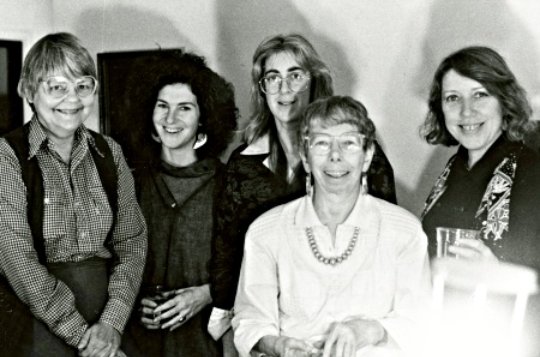The early editors of HOW(ever), L to R:
Bev Dahlen, Susan Gevirtz, Rachel Blau DuPlessis, Frances Jaffer & Kathleen Fraser
International Women’s Day is 101 today¹, a figure that reminds me that the Allen anthology, The New American Poetry – still the most influential single book of poems to have appeared in print in my lifetime – occurred pretty much at the halfway point in that history, gathering the post-avant poetries of the period between the end of the Second World War & 1960. That book has been rightly criticized for having just four women contributors among its 44, and for ignoring Diane di Prima, Joanne Kyger, Hettie Jones, Ruth Witt-Diamant, Muriel Rukeyser, ruth weiss, Kathleen Fraser, Josephine Miles, Mary Fabilli, Laura Ulewicz & others who could arguably have been included in that work.
I hate to admit that this situation was perceived, at least by myself & the male poets I knew, as “normal” back in the 1960s, but it was. In the 1960s, Gertrude Stein was still considered a joke as a writer, an extra-literary phenomenon of those crazy between-war years in Paris. H.D. was not thought about at all, unless Robert Duncan was talking. Tillie Olsen read at San Francisco State & gave away copies of Tell Me a Riddle because nobody had bothered to buy the book.
So that when Kathleen Fraser wrote about accepting her legs, Denise Levertov put a plaque on her washing machine crediting the Guggenheim Foundation for the machine’s ability to free up her time to write, and when Diane Wakoski began to create poems about – of all things – male sexism, these were all received quite differentially depending on what you had between your legs. Nor were these women alone – Florence Howe’s No More Masks dates from 1973, Judy Grahn’s The Psychoanalysis of Edward the Dyke stunningly all the way from 1964 (just two years after the then-LeRoi Jones put out Four Young Lady Poets, featuring Wakoski, Carol Bergé, Barbara Moraff & Rochelle Owens).
When I was a student at San Francisco State in the 1960s, there was exactly one woman on the creative writing faculty there, Kay Boyle, &, after I’d left, I was not surprised to hear that Boyle fought hard (tho unsuccessfully) to keep it that way, resisting the addition of Fraser to the full-time tenure-track elite. At Berkeley, the only women writers during my time there (Levertov, Lillian Hellman) were visiting faculty. And some of the women who taught literature (as distinct from writing) at Berkeley bought into the very male game that professors could have their pick of grad students as sexual partners. The good old days those were not.
So that when Kathleen Fraser – that name again – joined with some like-minded friends in 1983 to create HOW(ever), the timing was perfect: it proved to be an epoch-making event. Women’s writing already had a long, remarkable progressive history: it was not simply quietist poetry (with all of the politics of conformity that implies) written by women. I recall Kathleen telling me at one point that she was surprised at just how much support she got from male post-avants compared with the deafening silence that greeted the publication from the female quietists of that decade, some of whom had become quite famous as feminists. From my perspective, that made perfect sense.
Still, nothing has done more to change – blur, to some degree even erase – the faultlines for poetry in my lifetime than the mass emergence of women writing. For all of the problems that I have with the concept of hybridity in poetry, I can’t escape the fact that for many writers, especially those younger than myself, the bifurcation of poetry into two counter-posing traditions is experienced as a quarrel among men (white men at that), and that the landscape of poetry in the English language now looks entirely different.
Not that all is perfect. Far from it. It is still possible to have a major award shortlist that consists entirely of men, even though everyone now seems to concede that the absolute majority of poets writing in English are women. Further, this disparity continues to turn up in some of the ways women writers express themselves. Of the 1192 active blogs on my blogroll, 392 are written by women, slightly under 33 percent. For the next week, the top list on my new links page will consist of nothing but these women (and, knowing Blogger, that may be the only list visible). Now, it’s conceivable that one of the reasons for this disparity is me – if I’m missing anyone, send me an email and let me know. It’s also true that not all of the collective blogs are exclusively by men – Give a Fig missed this list because one of its 13 contributors is male. But the distance between the 25 percent figure that marked the participation by women in In the American Tree in 1986 and the 32.9 percent in my blogroll 24 years later is not the sign of a successful revolution so much as it is of one still very much in process.
Women who blog about poetry, poetics & the arts
¹ First observed February 28, 1909 by the Socialist Party of America, it was fomally adopted by the Second International in 1910 & celebrated internationally for the first time in 1911. Some organizations will celebrate its centennial next year.






